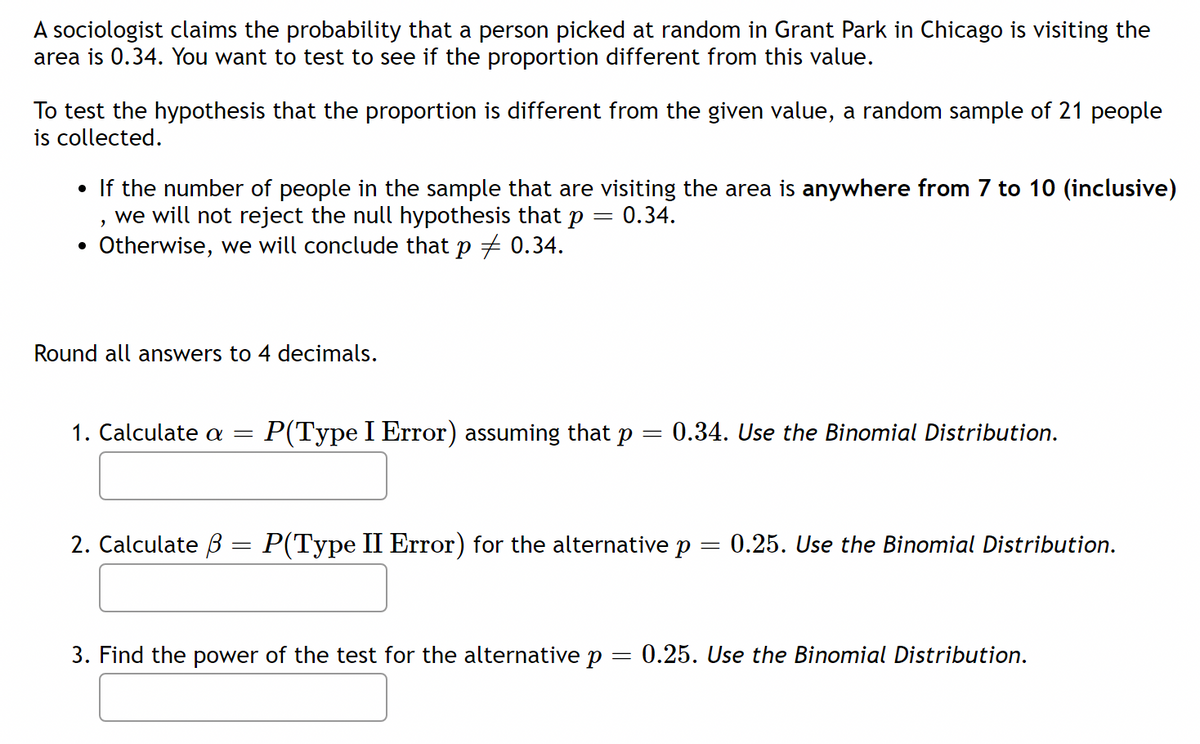A sociologist claims the probability that a person picked at random in Grant Park in Chicago is visiting the area is 0.34. You want to test to see if the proportion different from this value. To test the hypothesis that the proportion is different from the given value, a random sample of 21 people is collected. • If the number of people in the sample that are visiting the area is anywhere from 7 to 10 (inclusive) we will not reject the null hypothesis that p = 0.34. • Otherwise, we will conclude that p + 0.34.
A sociologist claims the probability that a person picked at random in Grant Park in Chicago is visiting the area is 0.34. You want to test to see if the proportion different from this value. To test the hypothesis that the proportion is different from the given value, a random sample of 21 people is collected. • If the number of people in the sample that are visiting the area is anywhere from 7 to 10 (inclusive) we will not reject the null hypothesis that p = 0.34. • Otherwise, we will conclude that p + 0.34.
College Algebra
7th Edition
ISBN:9781305115545
Author:James Stewart, Lothar Redlin, Saleem Watson
Publisher:James Stewart, Lothar Redlin, Saleem Watson
Chapter9: Counting And Probability
Section9.3: Binomial Probability
Problem 2E: If a binomial experiment has probability p success, then the probability of failure is...
Related questions
Question

Transcribed Image Text:A sociologist claims the probability that a person picked at random in Grant Park in Chicago is visiting the
area is 0.34. You want to test to see if the proportion different from this value.
To test the hypothesis that the proportion is different from the given value, a random sample of 21 people
is collected.
If the number of people in the sample that are visiting the area is anywhere from 7 to 10 (inclusive)
we will not reject the null hypothesis that p
Otherwise, we will conclude that p + 0.34.
0.34.
Round all answers to 4 decimals.
1. Calculate a =
P(Type I Error) assuming that p
0.34. Use the Binomial Distribution.
%3|
2. Calculate B = P(Type II Error) for the alternative p
0.25. Use the Binomial Distribution.
3. Find the power of the test for the alternative p
0.25. Use the Binomial Distribution.
Expert Solution
This question has been solved!
Explore an expertly crafted, step-by-step solution for a thorough understanding of key concepts.
Step by step
Solved in 3 steps

Recommended textbooks for you

College Algebra
Algebra
ISBN:
9781305115545
Author:
James Stewart, Lothar Redlin, Saleem Watson
Publisher:
Cengage Learning


College Algebra
Algebra
ISBN:
9781305115545
Author:
James Stewart, Lothar Redlin, Saleem Watson
Publisher:
Cengage Learning
